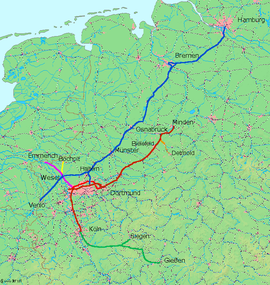Bocholt–Wesel railway
 Bocholt Raailway in Gelb | |
| Overview | |
|---|---|
| Line number | 2263 |
| Service | |
| Route number | 421 |
| Technical | |
| Line length | 20 |
| Track gauge | 1435 |
| Operating speed | 80 max. |
| German states: | North Rhine-Westphalia |
|} The Bocholt Railway is a single-track branch line in the German state of North Rhine-Westphalia from Wesel in the Lower Rhine region to Bocholt in western Münsterland.
History
In the middle of the 19th century, the town of Bocholt (including the cotton industry) developed plans to connect to the new railway network. In 1856, the Holland Line was opened by the Cologne-Minden Railway Company (Cöln-Mindener Eisenbahn-Gesellschaft, CME), but ran from Wesel along the Rhine via Emmerich to Arnhem, missing Bocholt. Several initiatives launched by businessmen from Cologne and Münster were not able raise the necessary capital to build a line to Bocholt.
On 26 May 1875, the CME finally received a concession for the construction of a branch line from Wesel to Bocholt, which was opened for passenger traffic on 1 July 1878.[1]
Two years later on 25 August 1880, the Dutch Westphalian Railway Company (Niederländisch-Westfälische Eisenbahn-Gesellschaft) opened the Winterswijk–Bocholt railway, turning the terminal station into a through station.[2] In 1901, after the nationalisation of most of Prussia’s private railway companies, the opening of the Empel-Rees–Münster railway by the Prussian state railways from Empel-Rees to Bocholt on 1 August 1901 and its continuation to Borken on 1 August 1902 made Bocholt into a junction station.[3]
Since the end of the 20th century, with the closure of the two newest lines, Bocholt station has become a terminus again.
Operations
The line is served by Regionalbahn service RB 32 (Der Bocholter). In Wesel it connects with Regional-Express service RE 5 (Rhein-Express) towards Oberhausen, Duisburg and on to Koblenz.
RB 32 is operated by DB Regio NRW hourly on weekdays and every two hours on Saturday afternoons and on Sundays. It is operated with diesel multiple units of DB class 628.4, which can only run at 80 km/h on this track, despite their maximum speed of 120 km/h.
The siding of the precast concrete plant of Max Bögl in Hamminkeln is served as necessary to supply materials for construction projects, mostly tunnels, by trains operated by Bocholter Eisenbahngesellschaft mbH on behalf of DB Schenker. A signalman is stationed at the precast concrete plant for this traffic.
The route is now part of DB’s Münster-Ostwestfalen (Münster-East Westphalia) regional network (MOW), which has its headquarters in Münster.
In the local press of 16 May[4] and 20 May 2011[5] it was revealed that the Verkehrsverbund Rhein-Ruhr (Rhine-Ruhr Transport Association, VRR) was undertaking a feasibility study that would examine the electrification of the Bocholt railway. After the upgrade, if necessary, the operations of Regionalbahn service RB 32 would be abandoned and Regionalbahn service RB 33 (Rhein-Niers-Bahn) would be extended to Bocholt. This would provide a through-service from Bocholt to the Ruhr region. The feasibility study was completed in January 2012.[6] In a press release of 22 March 2013 announcing the award of the operations of the Lower Rhine network to Abellio Rail GmbH from 2016, the VRR announced that the feasibility study on the electrification of the railway to Bocholt was much more positive than expected. The electrification with a design speed of 80 km/h would cost 'only' €12 million; with a design speed of 100 km/h it would cost €15 million, which is far below the initial estimates of €20 million. Electrification of the Bocholt Railway would allow it to be integrated into the Lower Rhine network. The VRR is undertaking further planning with the aim of completing the electrification in December 2016.[7]
-
Blumenkamp station
-
Dingden station
Notes
- ^ "Line 2263: Wesel - Bocholt". NRW Rail Archive (in German). André Joost. Retrieved 30 July 2013.
- ^ "Line 2264: Bocholt (Grenze) - Bocholt". NRW Rail Archive (in German). André Joost. Retrieved 30 July 2013.
- ^ "Line 2265: Empel-Rees - Münster (Westf)". NRW Rail Archive (in German). André Joost. Retrieved 30 July 2013.
- ^ Bocholter Borkener Volksblatt (in German). 16 May 2011.
{{cite news}}: Missing or empty|title=(help) - ^ Bocholter Borkener Volksblatt (in German). 20 May 2011.
{{cite news}}: Missing or empty|title=(help) - ^ "Strom für den Bocholter". Der Westen (in German). Retrieved 30 July 2013.
- ^ "VRR vergibt Niederrhein-Netz an Abellio Rail NRW" (Press release) (in German). Verkehrsverbund Rhein-Ruhr. Retrieved 30 July 2013.




